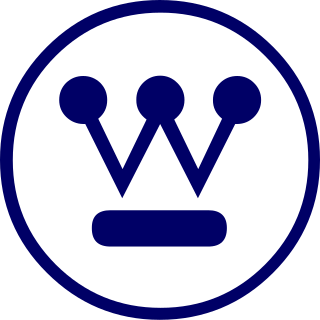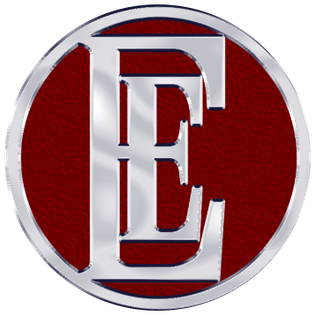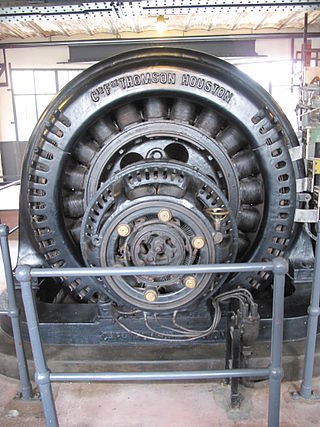Related Research Articles

Vickers was a British engineering company that existed from 1828 until 1999. It was formed in Sheffield as a steel foundry by Edward Vickers and his father-in-law, and soon became famous for casting church bells. The company went public in 1867, acquired more businesses, and began branching out into military hardware and shipbuilding.
The General Electric Company (GEC) was a major British industrial conglomerate involved in consumer and defence electronics, communications, and engineering. The company was founded in 1886, was Britain's largest private employer with over 250,000 employees in the 1980s, and at its peak in the 1990s, made profits of over £1 billion a year.

The Westinghouse Electric Corporation was an American manufacturing company founded in 1886 by George Westinghouse. It was originally named "Westinghouse Electric & Manufacturing Company" and was renamed "Westinghouse Electric Corporation" in 1945. The company acquired the CBS television network in 1995 and was renamed "CBS Corporation" until being acquired by Viacom in 1999, a merger completed in April 2000. The CBS Corporation name was later reused for one of the two companies resulting from the split of Viacom in 2005.

The English Electric Company Limited (EE) was a British industrial manufacturer formed after the armistice of World War I by amalgamating five businesses which, during the war, had been making munitions, armaments and aeroplanes.
Associated Electrical Industries (AEI) was a British holding company formed in 1928 through the merger of the British Thomson-Houston Company (BTH) and Metropolitan-Vickers electrical engineering companies. In 1967 AEI was acquired by GEC, to create the UK's largest industrial group. A scandal that followed the acquisition is said to have been instrumental in reforming accounting practices in the UK.
British Thomson-Houston (BTH) was a British engineering and heavy industrial company, based at Rugby, Warwickshire, England. Originally founded to sell products from the Thomson-Houston Electric Company, it soon became a manufacturer using licenses from the American company. They were known primarily for their electrical systems and steam turbines.

Metro-Cammell, formally the Metropolitan Cammell Carriage and Wagon Company (MCCW), was an English manufacturer of railway carriages, locomotives and railway wagons, based in Saltley, and subsequently Washwood Heath, in Birmingham. Purchased by GEC Alsthom in May 1989, the Washwood Heath factory was closed in 2005.
Metropolitan-Vickers, Metrovick, or Metrovicks, was a British heavy electrical engineering company of the early-to-mid 20th century formerly known as British Westinghouse. Highly diversified, it was particularly well known for its industrial electrical equipment such as generators, steam turbines, switchgear, transformers, electronics and railway traction equipment. Metrovick holds a place in history as the builders of the first commercial transistor computer, the Metrovick 950, and the first British axial-flow jet engine, the Metropolitan-Vickers F.2. Its factory in Trafford Park, Manchester, was for most of the 20th century one of the biggest and most important heavy engineering facilities in Britain and the world.

The Thomson-Houston Electric Company was a manufacturing company which was one of the precursors of the General Electric company.

The British Rail Class 82 electric locomotives were designed by the British manufacturing interest Metropolitan-Vickers and produced by Beyer, Peacock and Company on behalf of British Rail (BR).
Dick, Kerr and Company was a locomotive and tramcar manufacturer based in Kilmarnock, Scotland and Preston, England.
Vickers Limited was a British engineering conglomerate. The business began in Sheffield in 1828 as a steel foundry and became known for its church bells, going on to make shafts and propellers for ships, armour plate and then artillery. Entire large ships, cars, tanks and torpedoes followed. Airships and aircraft were added, and Vickers jet airliners were to remain in production until 1965.
The Drewry Car Co was a railway locomotive and railcar manufacturer and sales organisation from 1906 to 1984. At the start and the end of its life it built its own products, for the rest of the time it sold vehicles manufactured by sub-contractors. It was separate from the lorry-builder, Shelvoke & Drewry, but it is believed that James Sidney Drewry was involved with both companies.
This list collects the transport-related vehicles exhibited or owned by the Museum of Transport and Technology (MOTAT) in Auckland, New Zealand.
GEC Traction Limited was a British industrial company formed in 1972 which designed and manufactured electric traction equipment for railway rolling stock. The company had manufacturing sites at Manchester, Preston and Sheffield and was a wholly owned subsidiary of General Electric Company.

Metropolitan Railway electric locomotives were used on London's Metropolitan Railway with conventional carriage stock. On the outer suburban routes an electric locomotive was used at the Baker Street end that was exchanged for a steam locomotive en route.

Metropolitan Railway electric multiple units were used on London's Metropolitan Railway after the lines were electrified in the early 20th century.

The First International Tramways and Light Railways Exhibition was held in the Royal Agricultural Hall, Islington, London from 30 June 1900 – 11 July 1900.

An internal combustion locomotive is a type of railway locomotive that produces its pulling power using an internal combustion engine. These locomotives are fuelled by burning fossil fuels, most commonly oil or gasoline, to produce rotational power which is transmitted to the locomotive's driving wheels by various direct or indirect transmission mechanisms. The fuel is carried on the locomotive.

MetroVick electric vehicles were a range of battery electric road vehicles produced by the heavy engineering company Metropolitan-Vickers between 1934 and 1944. The company was renamed Metropolitan-Vickers in 1919, and entered the electric vehicle market in 1934, when they bought up the General Vehicle Company of Birmingham. They inherited the designs for the Gordon range of models, and continued to service and supply parts for the G.V. Electric vehicles. Their main sales seem to have been of light vans and dairy vehicles, in three sizes, which they promoted through a series of exhibitions. During the Second World War, they experienced difficulties in obtaining raw materials, and the number of vehicles that could be built was severely restricted by quotas. Production of the range ceased entirely in 1944, and when hostilities ceased, they sold the electric vehicle business to Brush in 1945.
References
- ↑ Desmond, Kevin (2019). Electric Trucks: A History of Delivery Vehicles, Semis, Forklifts and Others. Jefferson, North Carolina: McFarland. ISBN 978-1-4766-3618-4 . Retrieved 28 January 2020.
- ↑ "British Westinghouse" . Retrieved 5 August 2016.
- ↑ "A Westinghouse petrol-electric, narrow gauge locomotive (centre) with the British War Department (BWD) number LR2006 B and Works number 1149 (not visible). The cab of a Dick, Kerr Company ..." Retrieved 5 August 2016.
